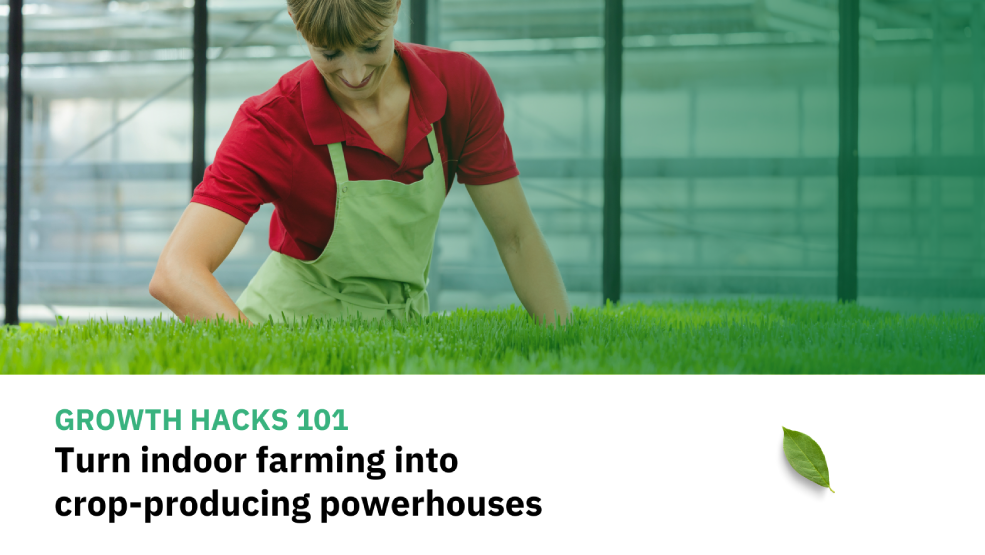HVAC systems and climate control: how do they complement each other, save your time, and help in creating sustainable agriculture? Let’s find out!
Indoor farming, or vertical farming, is growing at an increasing rate, predicted to value US$ 1,06,963.1 million by 2033. This could be because of sustainable agriculture or people’s desire to have a greener home—it doesn’t matter. What does matter is how successful indoor farming is. That means looking at temperature, humidity, and air control—and this is where an HVAC system comes in.
Whether we’re talking about Greenhouse HVAC, ventilation systems, or specialized setups for growing rooms, they all work together to regulate key factors like temperature, humidity, and air quality. To truly master indoor farming, it’s crucial to understand the ins and outs of these diverse HVAC systems, optimizing the whole agricultural process.
Three benefits of HVAC systems in indoor farming
When you install an HVAC system, it is not just about helping the environment and cutting down on carbon footprint. It also does other cool stuff like keeping the air clean, managing humidity, and making sure the temperature is just right.
1.Air quality: HVAC systems help to properly ventilate and circulate the air, ensuring that fresh, clean air is constantly being circulated throughout the space. This helps to prevent stagnant air from accumulating, which can lead to the buildup of harmful bacteria and mold.
2. Humidity: HVAC systems, which are like big air conditioners, control the moisture levels in the air. By which you can prevent diseases and mold from growing on the plants. When the humidity is balanced, it can really help the crop seeds to sprout and grow well and make the plants better at fighting off diseases and pests. This means we don’t have to use as many chemicals to keep the plants healthy, which is better for the environment.
3.Temperature regulation: Temperature controls make sure there is a consistent environment ensuring optimal performance. By using the up and down arrows on the temperature control panel, you can easily adjust the temperature settings to fit your specific needs. Controlled lighting also plays a critical role in supporting plant development and ensuring that every crop receives the right amount of light for optimal growth.
Role of HVAC systems in vertical farming
The application of HVAC (Heating, Ventilation, and Air Conditioning) systems in vertical farming extends across various sectors, ensuring optimal conditions for plant growth and produce preservation. These systems find indispensable roles in
Greenhouse farming:
HVAC maintains optimal temperature, humidity, and air quality to foster ideal conditions for plant growth.
Warehouse farming:
Regulating temperature and ensuring proper air circulation, HVAC systems play a vital role in preserving harvested produce within warehouse settings.
Container farms:
In indoor farming environments such as container farms, HVAC systems create a controlled atmosphere, crucial for cultivating crops efficiently.
Other vertical farming applications:
HVAC systems are essential in diverse settings, including vertical farms incorporated into buildings. Here, precise climate control is achieved through HVAC technology to promote optimal plant growth and maximize yields.
What are smart indoor farming technologies?
1. Precision climate control
Precision climate control systems in indoor farms offer a range of features to ensure the perfect growing environment for plants. These systems regulate temperature, control humidity levels, and monitor CO2 levels, creating the ideal conditions for plant growth. Smart sensors and automation play a crucial role in optimizing energy use based on the specific requirements of different crops. By adjusting climate control settings in real-time, these systems minimize energy wastage and reduce the workload on HVAC systems.
Additionally, precision climate control systems allow for customized settings for different crop varieties, ensuring that each plant receives the exact climate conditions it needs to thrive. Ultimately, these systems help vertical farms maximize their energy efficiency while also increasing the overall yield and quality of their harvests.
2. LED lighting technology
LED lighting technology is well-suited for vertical farming because of its high efficiency and ability to provide the right light spectrum for plant growth. By optimizing the light spectrum, LEDs can ensure that plants receive the specific wavelengths they need for photosynthesis and growth, leading to higher yields and better quality produce. Additionally, LED lighting also reduces maintenance costs due to its long lifespan and low heat output.
When it comes to indoor farming, utilizing a circular canopy layout with LED lighting can offer several advantages. This layout ensures that light is distributed evenly to all plants, maximizing growth potential. Optics play a crucial role in this setup by directing and controlling the light output, ensuring that each plant receives the necessary amount of light for optimal growth. Furthermore, the use of optics can help minimize wasted light, leading to increased efficiency and cost savings.
3. Waste heat recovery
Waste heat recovery technologies for vertical farming HVAC systems are a clever way to capture and reuse the excess heat produced. This excess heat can be harnessed and repurposed for water heating or powering absorption chilling systems. By doing this, we are able to reduce energy consumption for heating purposes and increase overall energy efficiency. This not only helps the environment by lowering our energy usage but also offers cost savings through the reuse of heat energy. utilizing waste heat recovery, not only makes sense from an environmental standpoint, but it’s also a smart financial decision.
Worried about the maintenance of HVAC systems?
Until now, we have only discussed the significance of HVAC systems and how they promote sustainable agriculture by way of indoor farming. But how do you maintain your HVAC systems? Let’s discuss some of the strategies you can adopt to make sure your HVAC system will keep running smoothly.
An HVAC system performing optimally and without fail is essential for crop production. Ensuring regular maintenance can be challenging, but field service management software, can help to ease this burden. The benefits of FSM software are too numerous to list here, so we encourage you to sign up for our free demo, where you can see all the benefits for yourself and how they apply to your business.
But before you run off, consider these three core benefits of using HVAC systems in conjunction with FSM software.
1. Integrations
We discussed LED lighting, automation, sensors, and so on. All these have to be integrated into the HVAC systems, and FSM software makes it easy. Field service management software can integrate with these technologies, providing a centralized platform for real-time monitoring and control of HVAC systems.
2. Task coordination and scheduling
FSM software facilitates efficient task coordination and scheduling, ensuring that routine maintenance, inspections, and adjustments for HVAC systems are carried out seamlessly. This helps in preventing disruptions to the controlled environment, allowing for consistent and optimal conditions for plant growth.
3. Data analytics for decision-making
FSM software provides robust data analytics tools that enable your customers to make informed decisions. By analyzing data related to HVAC system performance, energy consumption, and environmental conditions, customers can optimize settings and implement strategic changes to improve overall crop yield and resource efficiency.
Improve sustainable farming with HVAC
Sustainable farming with increased crop yield, using energy-saving practices is the future of agriculture. By using less energy, HVAC systems reduce greenhouse gas emissions, which contribute to climate change, appealing to environmentally conscious consumers. However, we cannot deny that these HVAC systems are utilized most fully when connected with field service management software. So, the growth hack to turn your indoor farms into crop-producing powerhouses is to connect your HVAC system with an FSM solution.
Step up and be a force for good. For every T-shirt you wear, over 700 gallons of water is consumed. You hold the power to reclaim gallons of water with every garment you wear. Choose minimalism; Save water. Mindful closet for a sustainable future!





